Building with Ice
Saranac Lake's Winter Carnival is a wonderful Adirondack festival. One of the strongest attractions happens even before Carnival officially begins. That would be the building of each year's Ice Palace.
Festivities began back at the turn of the century, when Saranac Lake was already established as an internationally famous wellness center. Between winter enthusiasts, experienced ice harvesters looking for a fun challenge, and everyone wanting another winter holiday, the Winter Carnival was born. It has since evolved into a highly popular festival, stretching out over ten days, and spanning two weekends.
The catchall term "Ice Palace" has been adopted because this very Carnival structure varies so widely from year to year. It is based upon each Carnival's unique theme. The first one was a tower of ice. Recently, it was a UFO theme, with a flying saucer built of ice. Whatever the chosen theme that year, each Palace is built as an actual building, with doorways and interior rooms and interesting furnishings and architectural details which Carnival-goers are welcome to explore. There's a surprise around every turn!
As delightful as the castle is every year, no one can book a stay in the ice palace- yes this question is asked. Most of our Saranac Lake lodging is very close by, so you won't miss a thing and will be warm and toasty while you sleep.
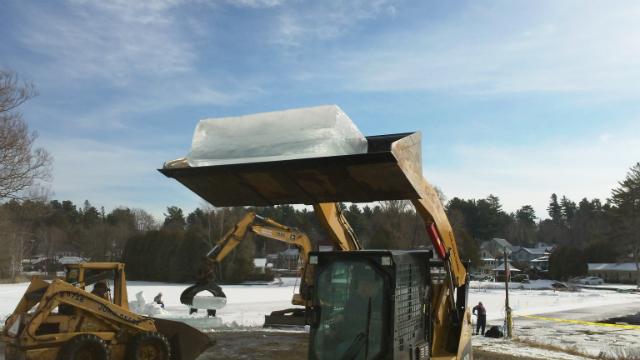
Once the year's theme is set, a group of talented volunteers meet at a local restaurant. They will pool any architectural, construction, and engineering experience to sketch out their vision on a napkin. This gets translated to actual blueprints which are kept at the building site on the shore of Lake Flower. This year, 2014, the theme is "Celtic Carnival" and so a castle was the obvious choice!
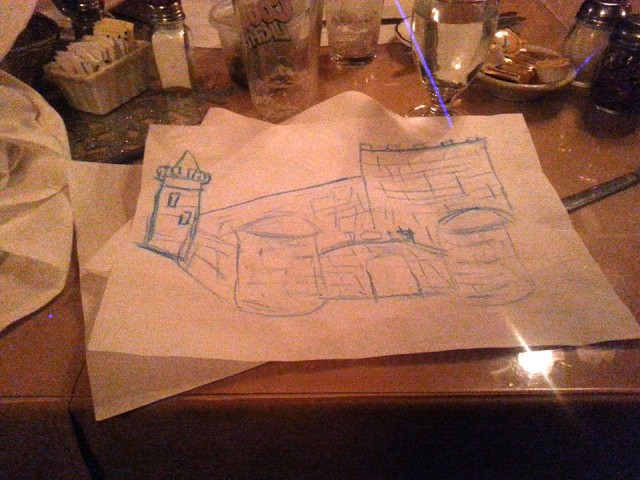
We have the most abundant, and least expensive, materials available: ice blocks! Is it as easy as "cut them out" and "stack them up"? Well, that's a start.
Timing becomes vital as Carnival approaches. Ice is very sturdy and durable, as long as the temperatures stay steady and low. The builders cannot start too early, because the structure might weaken as the weather changes. They also cannot start too late, and not have enough time for the building process.
A crucial element is ice thickness. This year, we have 15" of ice, so the plans should be completed as designed. Some years, the ice might be thinner, and the buildings are scaled back to accommodate a smaller block size.
Every year, we get a block which has a fish frozen in it, a children's favorite. This block is placed in a prominent spot in the structure. (Don't worry. This Carnival Fish gets returned to the lake and will thaw out on schedule.)
Before electricity-powered appliances became common, the ice trade, also called the frozen water trade, was an important 19th-century industry, predominant on the eastern coast of the United States (for North America) and Norway (for Europe.) It was invented in 1806, and proved so practical and popular it revolutionized the food and drink industries for more than a hundred years. Fresh ocean fish could be sold much further inland, chilled drinks became an American fad, and ice cream was developed commercially and proved wildly popular.
Blocks would be cut from the lake and buried in sawdust to insulate them. Since many towns in the area were also lumbering centers, sawdust was abundant, too. Railroads and ice wagons would ship the ice further south for people to be able to keep their food much longer in summer temperatures. Did Grandma and Grandpa call their refrigerator an "icebox"? That's because, for the longest time, it was.
As seen here, in this Word War I public-spirited poster, it was vital to national interests, too. While at this time "plant ice," which was frozen with the help of refrigeration, was becoming more and more popular, the war's energy needs meant fuel could not be used to make ice, and there was a final ice trade resurgence at this time.
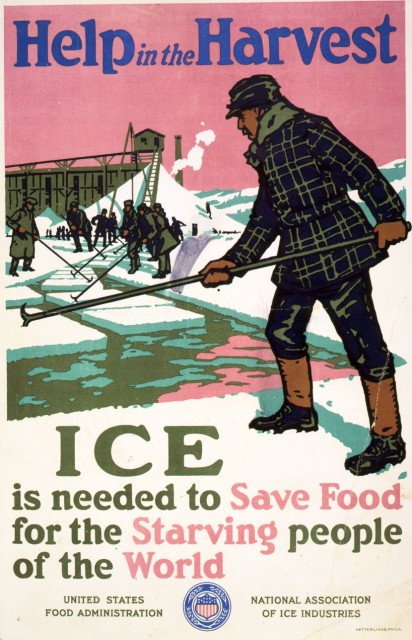
Cutting the ice was once done with teams of horses. Now, a circular saw is adapted to slide along the ice. Final cutting, then and now, uses handsaws from the lumbering industry. This was the summer work of the ice harvesters. As seen below, as blocks are cut further and further out from the building site, workers float the ice blocks to the crane which plucks them from the water.
This crane, as with all heavy equipment, is too heavy to actually go out on even this thick ice. When a system of pulleys, "snow slides," and sleds were used with teams of horses, the equipment was light enough to go where the ice was being cut. As heavy machinery replaced horses, techniques changed with the times.
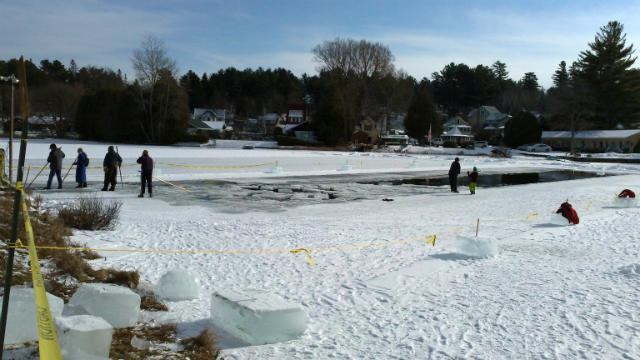
We have plenty of ice blocks to create safety fencing, build pallets to hold equipment, and build steps so workers can get to the top of the growing structure. As the structure grows, so do the eager crowds who come to watch the builders at work.
Brightly colored buckets hold the mortar which cements the ice blocks together; snow mixed with water. "Slushers" wear protective orange gloves to pat their mortar into place. Building is a very colorful activity!
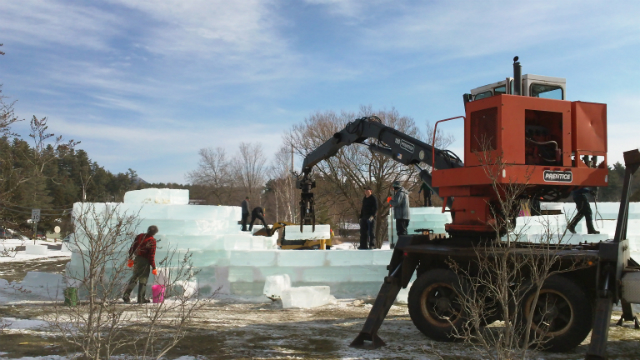
The ice saws, tongs, and picks are the exact same tools that were developed in the 1800's as the ice trade developed. While we use front loaders and cranes instead of horse teams with gears and pulleys, the way ice is harvested, for whatever purpose, has not changed in over two hundred years.
The ice blocks still need to be cut as squarely as possible, for snug stacking and so the mortar does not develop overly thin areas which can cause early melts. Each wall, no matter its shape, is constructed with the classic overlap pattern of bricklaying. Then and now, the labor is physically demanding.
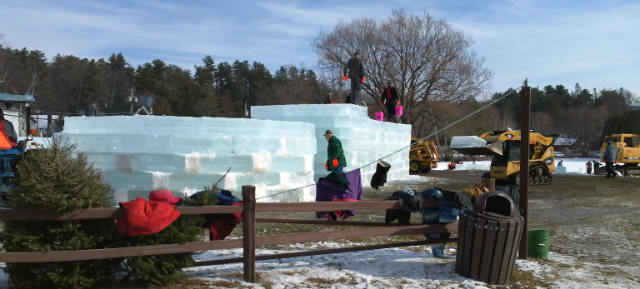
This fence holds the layers the workers shed as the day goes on. While temperatures are obviously below freezing, and usually considerably lower, our Alpine climate keeps us warm, and physical activity can generate enough body heat that a person will need less insulation.
Come to Winter Carnival! It's a fun way to enjoy winter, it has activities at every turn, most of them are free, and you will wind up having a much "warmer" time than you might expect.












